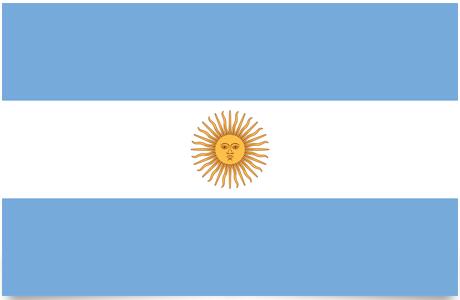Argentina Flag and Meaning
Flag of Argentina

Argentina Flag Meaning
The Argentine flag arose in 1812 and then consisted of three horizontal bands, two light blue and one white. It was not until 1818 that the yellow sun in the middle was added to the flag. The blue color is said to symbolize the sky, the white clouds and the yellow sun. The sun on the flag is a copy of the first Argentine coin.
The flag with the sun is called the official ceremonial flag and a flag without sun is called an ornamental flag. Both of these flags are considered to be the national flag, so when the ornamental flag is hoisted, the ceremonial flag must always be hoisted under it. On the ceremony flag the sun must be embroidered according to tradition.
Argentina Overview
| Population | 37 million |
| Currency | Argentine pesos |
| Area | 2,766,889 km² |
| Capital city | Buenos Aires |
| Population density | 13.3 residents/km² |
| HDI location | 46 |
In the western part of the country, the Andes mountain range runs from south to north. At the foot of the Andes are a number of fertile irrigation-based agricultural areas. Here sugar cane and citrus fruits are grown in the north and grapes in the central parts. To the east of the Andes, the plains spread: In the north the Chacos Plain which has subtropical climate and where cotton is grown. In the country’s central region is the Pampasslet, which has fertile and deep soils, temperate climate and is characterized by sheep and cattle farming as well as the cultivation of wheat, maize, soy and hay. In the southern part is Patagonia, a gold and cold low-lying steppe plateau. It is characterized by sheep farming and the extraction of oil. Argentina also demands supremacy over Malvinas(Falkland) archipelago in the southern Atlantic off Tierra del Fuego (Fire) and north of Antarctica. The discharge of untreated sewage has exacerbated the pollution of several rivers – especially Matanza-Riachuelo in Buenos Aires. Another serious ecological problem is the rising soil erosion, especially in the northern part of the humid Pampas.
The people: The majority of the Argentine population are descendants of European emigrants – especially from Italy and Spain – who arrived in large numbers in the period 1870-1950. Among them, Latin America’s largest Jewish community. According to unofficial estimates, the original population consists of 447,300 people, divided into 15 people and 3 mixing groups. They are especially concentrated in the north and southwest of the country as well as the slums of the larger cities. The Mapuchas, Kollas and Tobas are the largest ethnic groups. The indigenous peoples in the south, east and central parts of the country are being eradicated.
Religion: Catholic (92%, official religion). In addition, Protestant, Evangelical, Jewish and Muslim minorities.
Language: Spanish. A small part of the population speaks quechua, guaraní and other indigenous languages.
Political parties: Partido Justicialista (PJ, the Peronist Party) is the ruling party; Alianza Electoral (Valgalliancen) is a coalition of Unión Cívica Radical (UCR, the Radical Civil Union) and Frepaso, which in turn is a coalition of ex-Communists, Socialists, Independents, Partido Intransigents and ex-Peronists, Izquierda Unida and Partido. Socialista Popular (The Socialist Party); Alternative to a Republic of the Iguales (ARI); Frente para el Cambio/Polo Social (FC); Autodeterminación y Libertad (AL); Alianza del Centro Liberal (Liberal Center Alliance), consisting of the parties Demócrata Progresista, Autonomista, Federal, Demócrata, Modin(nationalist), Unión de Centro Democrático (UCeDé) and Fuerza Republicana (Republican Force) – the latter three linked to the military dictatorship of the 80’s; Partido Humanista; Movimiento al Socialismo; Partido Socialista Auténtico; Partido Comunista; Movimiento Socialista de los Trabajadores (MST); Convergencia Socialista (CS).
Social organizations: The Confederación General del Trabajo (CGT, the country’s LO), of Peronist observation, was formed in 1930. As a result of the current government’s economic and professional policy, it is divided into 3 factions. Central de Trabajadores Argentinos (CTA). Madres de Plaza de Mayo (different trends). Federación Agraria Argentina. Federación Universitaria Argentina. Movimiento Ecuménico por los Derechos Humanos. Pueblos Indígenas.
Official name: República Argentina
Administrative subdivision: 4 regions with 23 provinces, the Federal District of Buenos Aires (Metropolitan Area) and the Territorio Nacional de Tierra del Fuego (National Wildlife Territory).
Capital: Buenos Aires, 13,356,000 in (2009).
Other important cities: Córdoba, 1,521,700 residents; Rosario, 1,339,100 residents; Mendoza, 957,400 residents; La Plata, 813,800 residents (2000).
Government: Presidential Board. Mauricio Macri, President since December 2015. The Legislative Assembly (Congreso Nacional) is a two-chamber system consisting of the Chamber of Deputies (with 257 members) and the Senate (with 72). Each province and metropolitan area holds 3 seats in the Senate.
National Day: May 25 (Revolution 1810), July 9 (Independence 1816)
Armed Forces: 67,300 (Army 60%, Navy 26.8% and Air Force 13.2%)
Paramilitary forces: 18,000 (Gendarmerie)













































